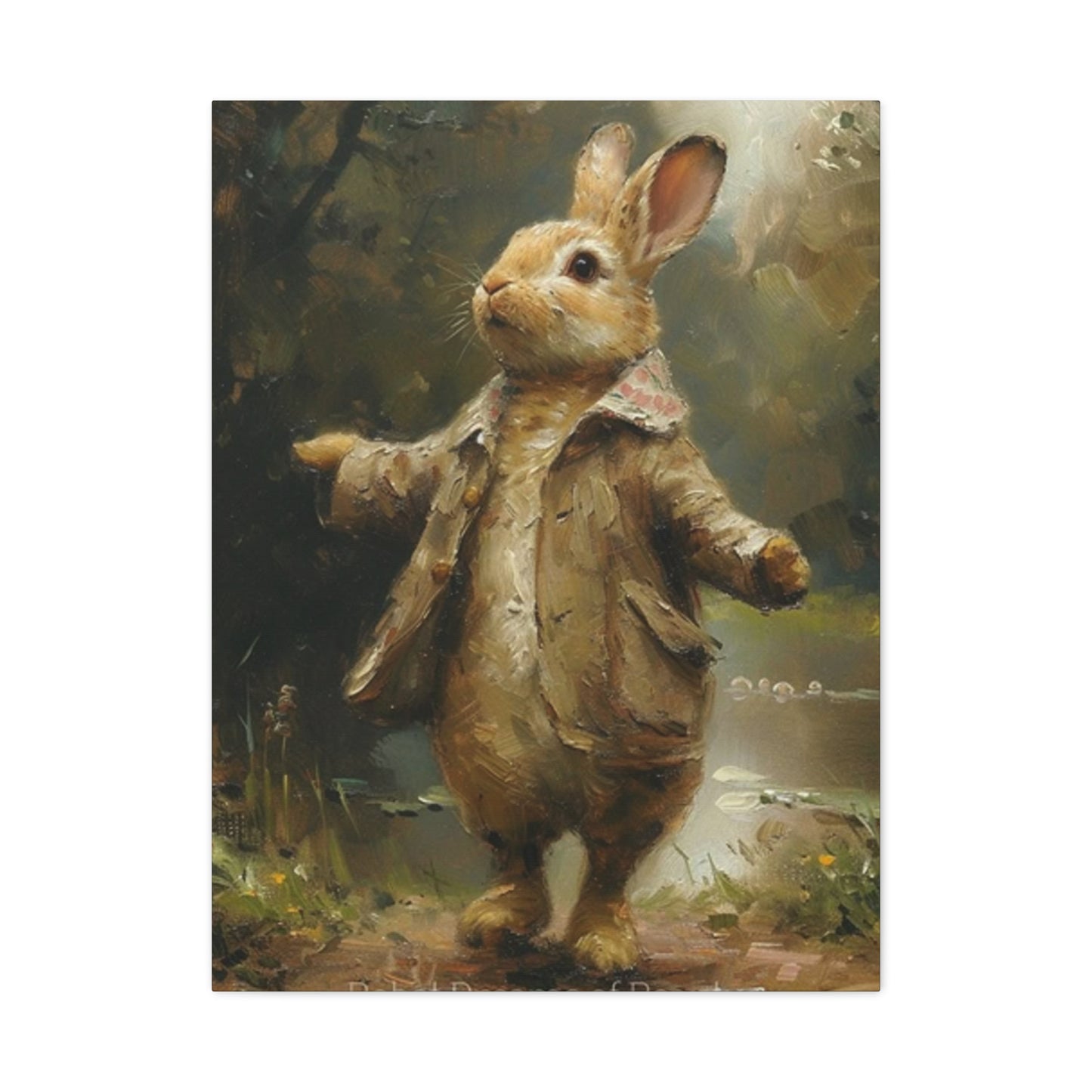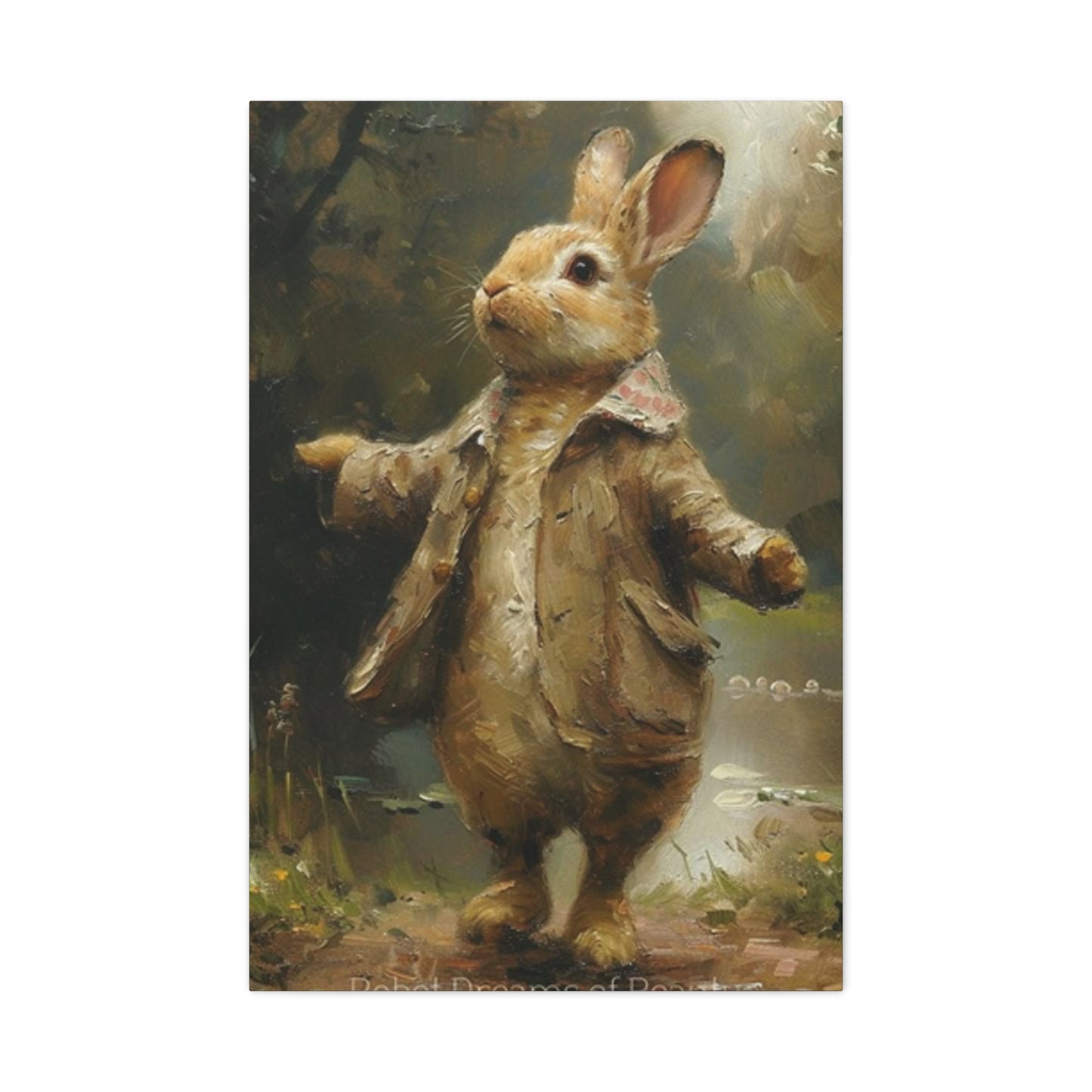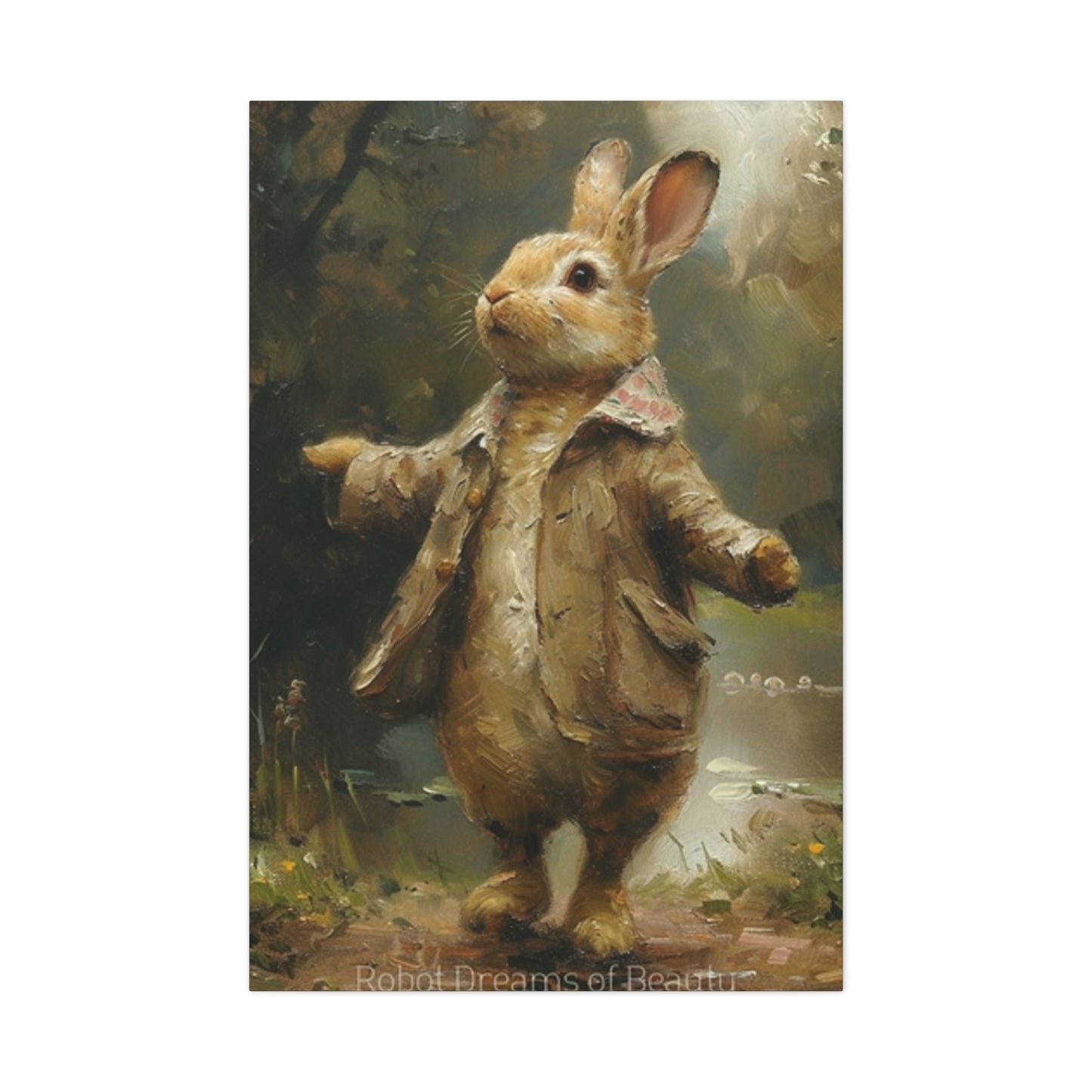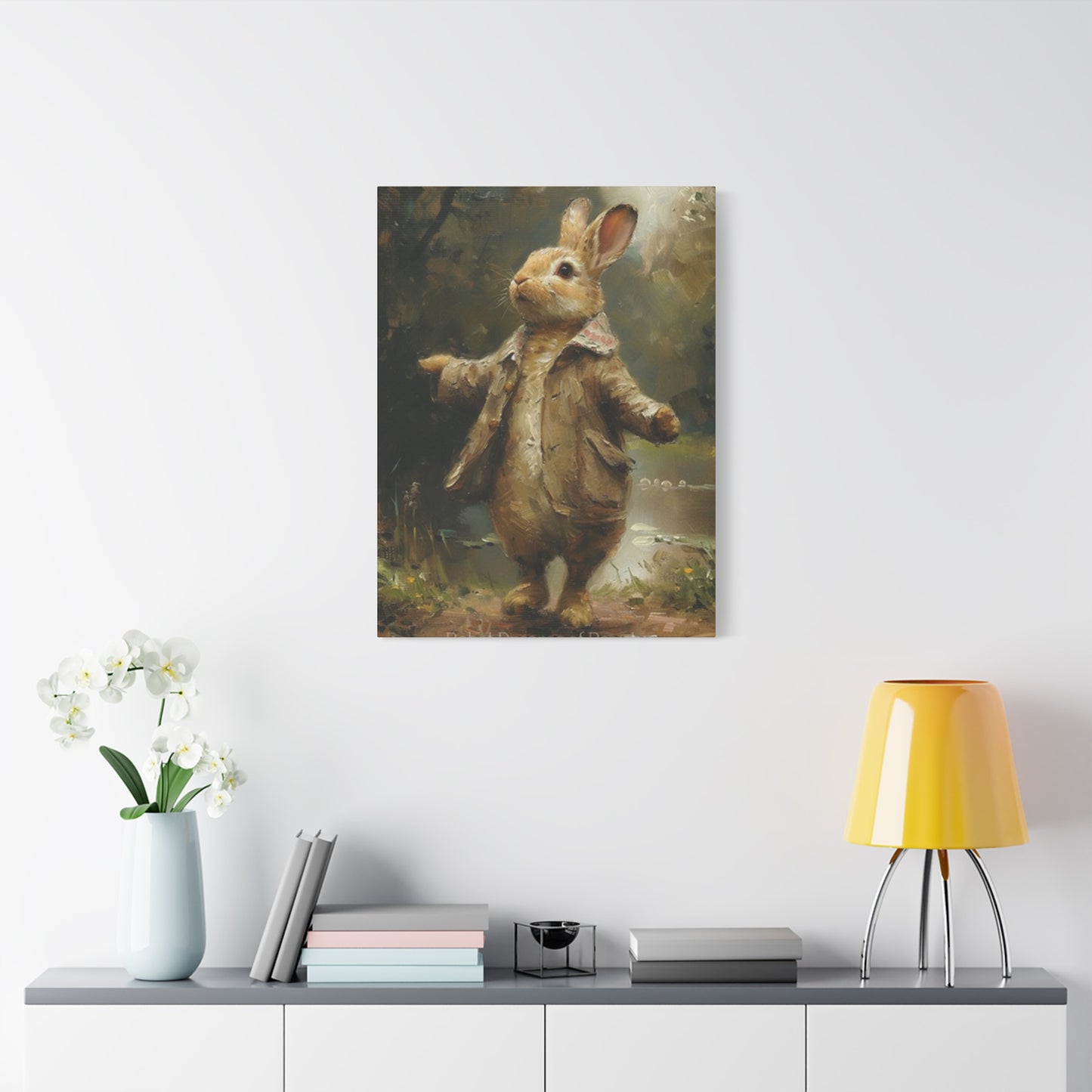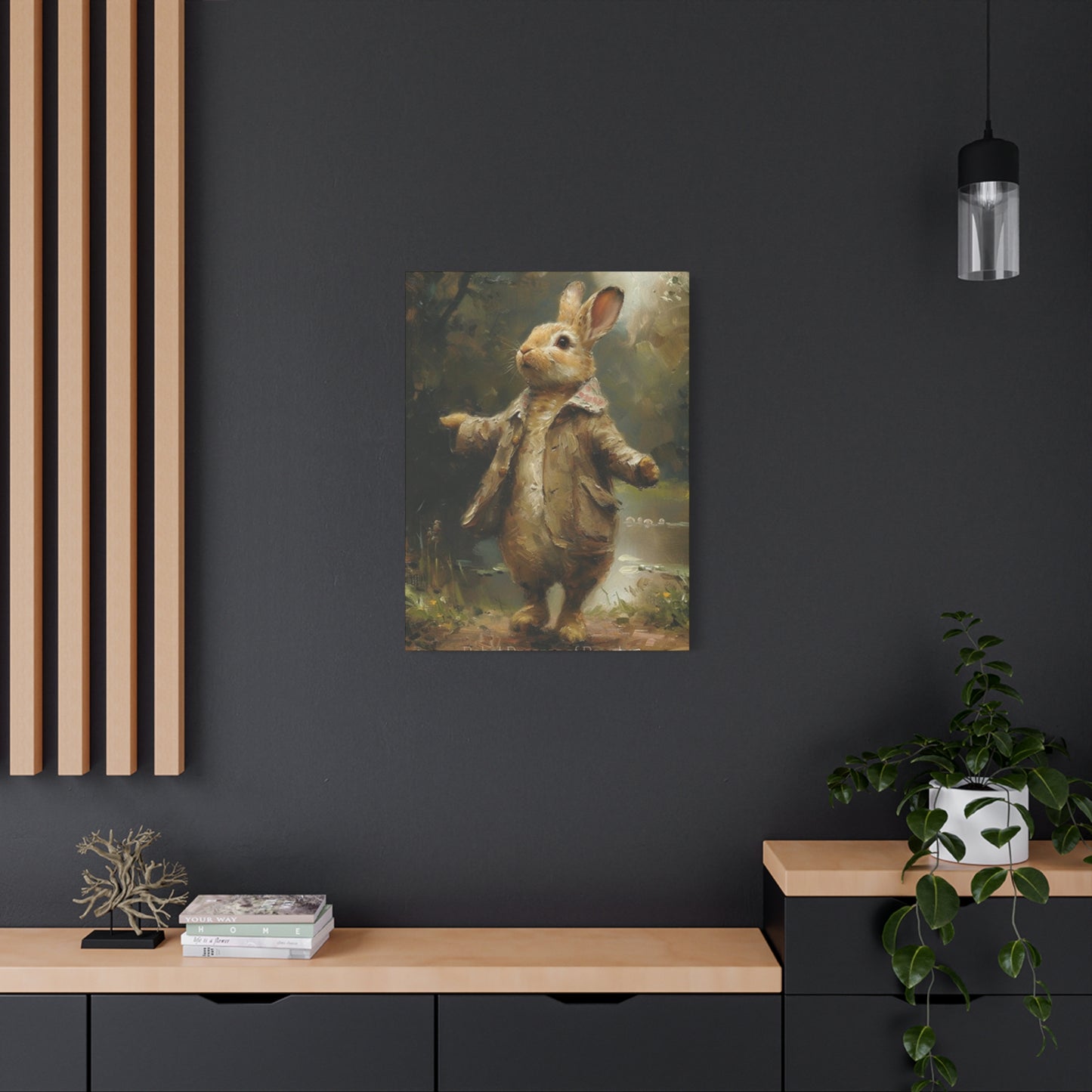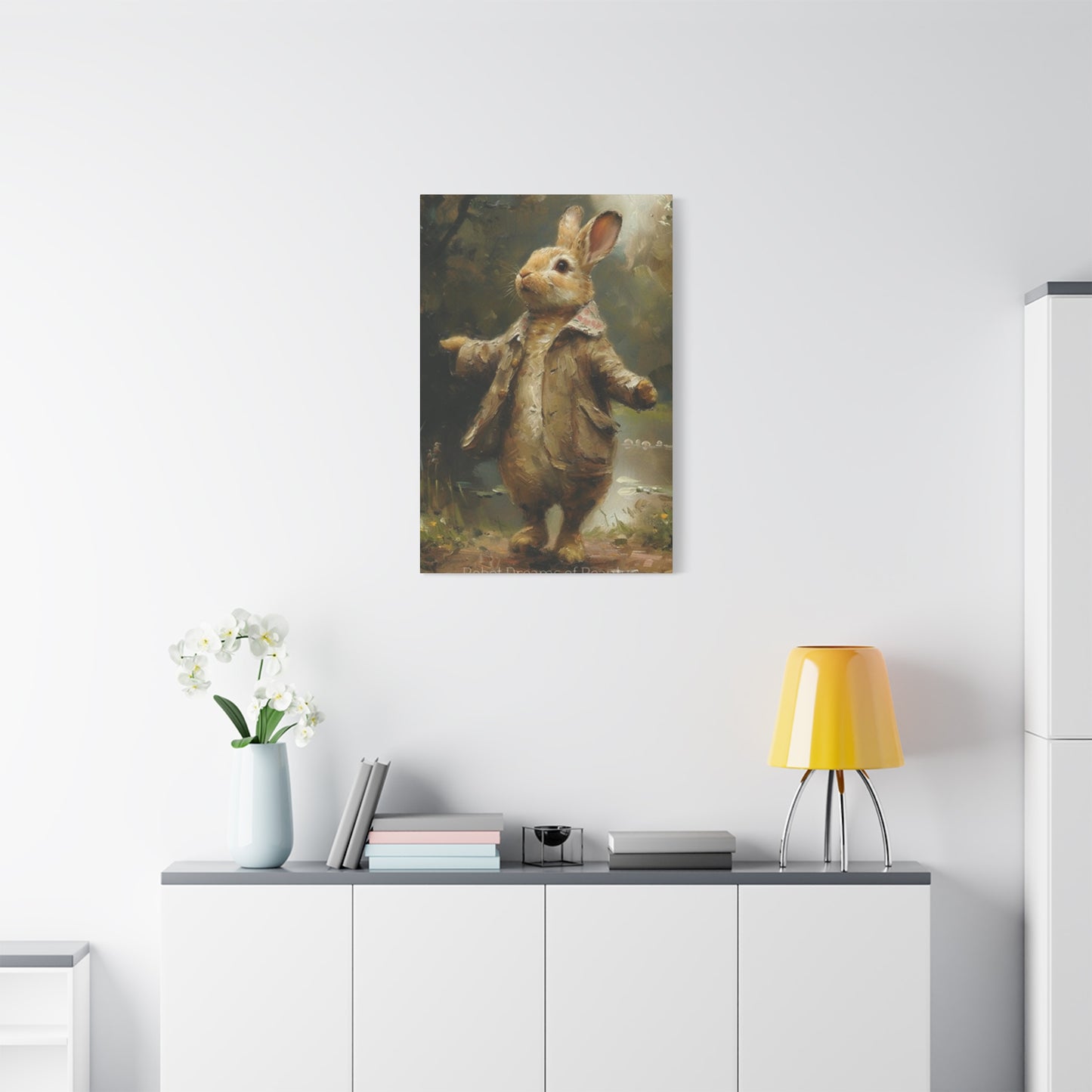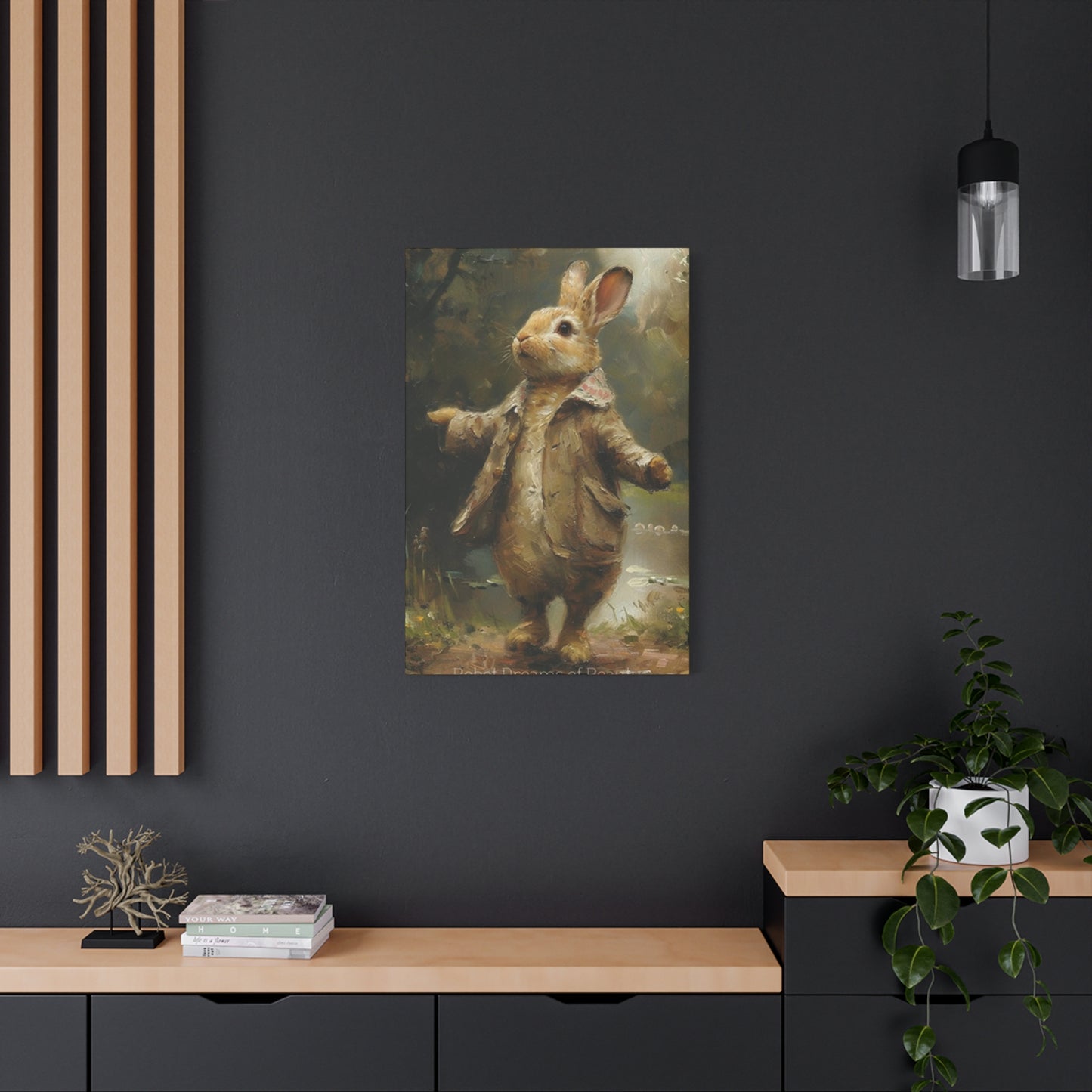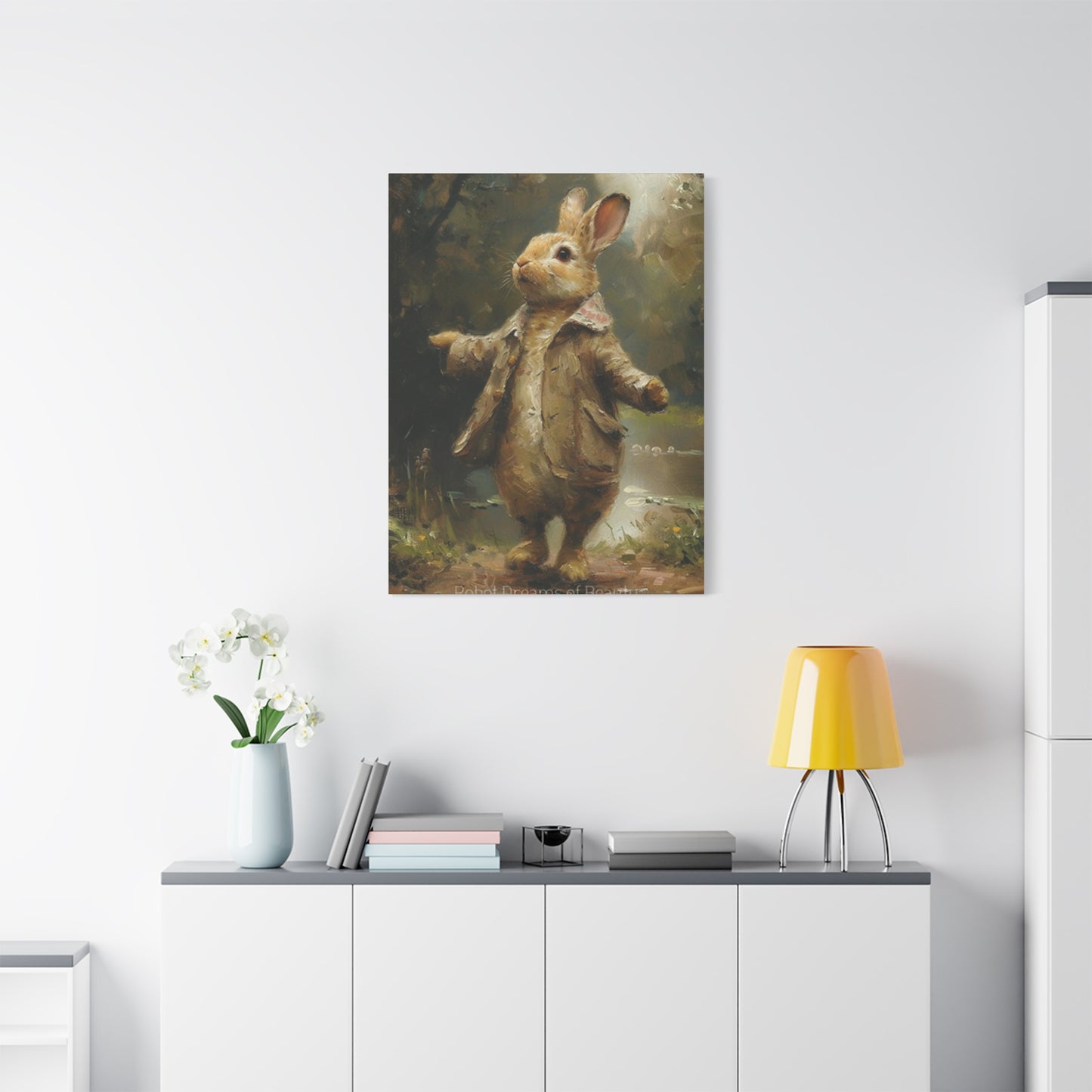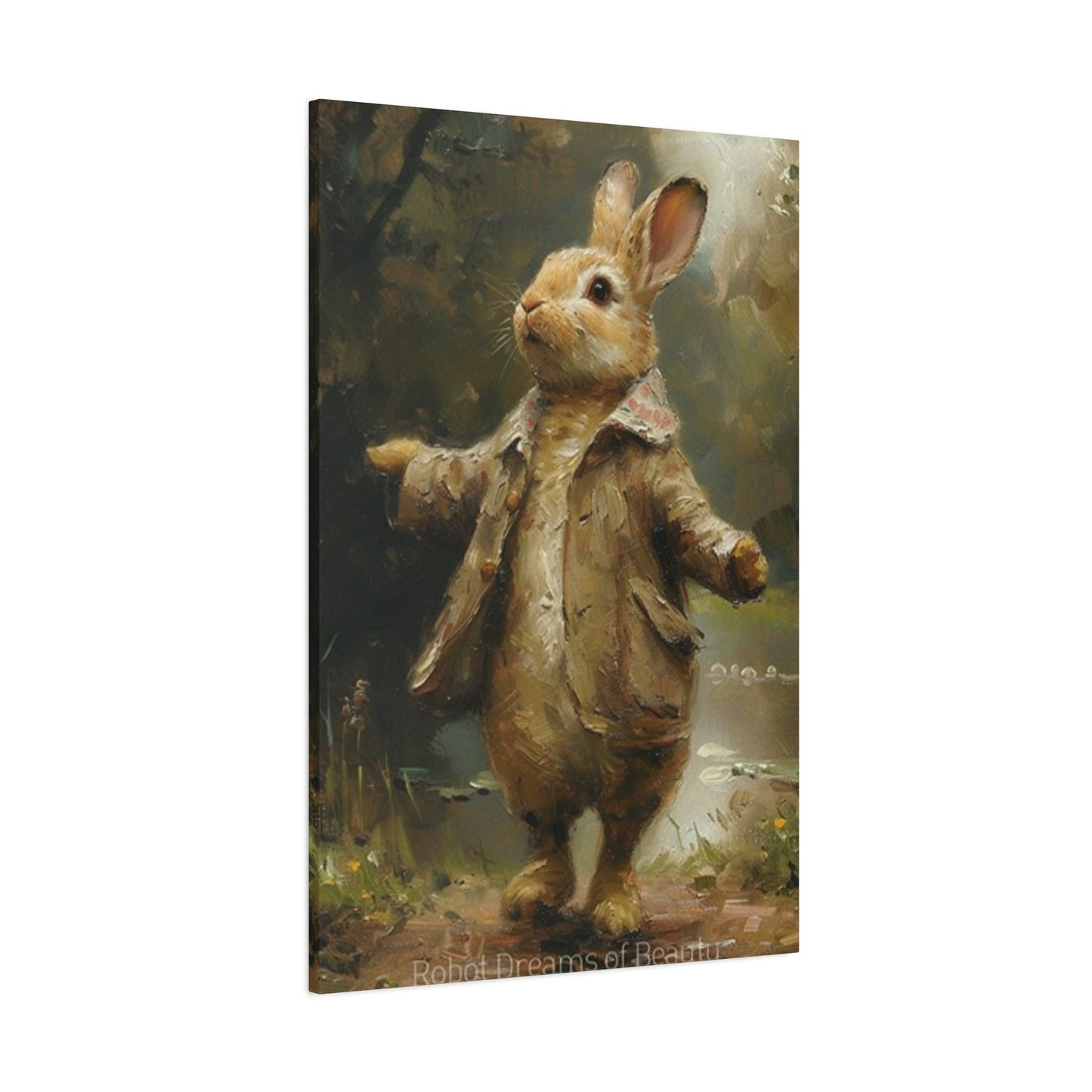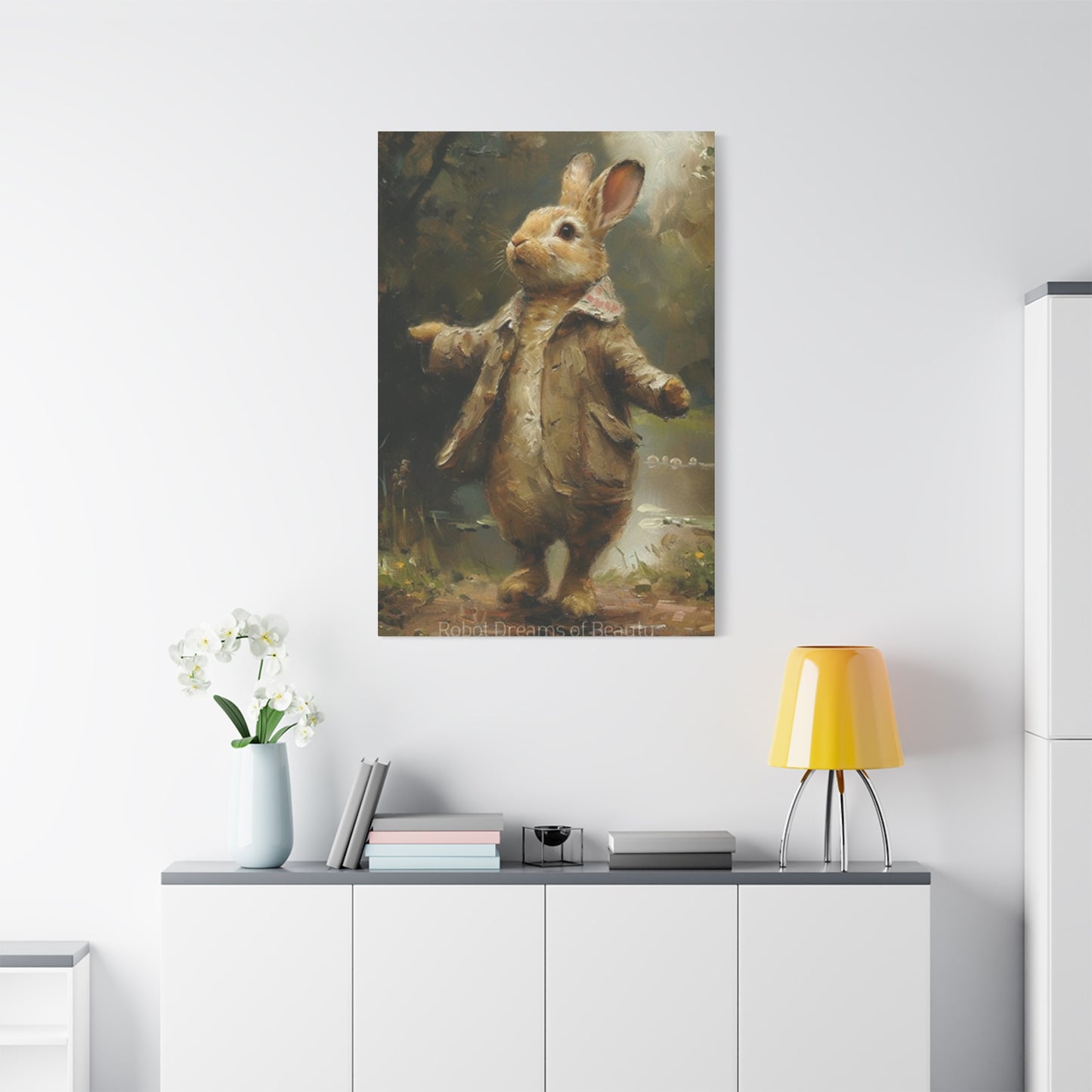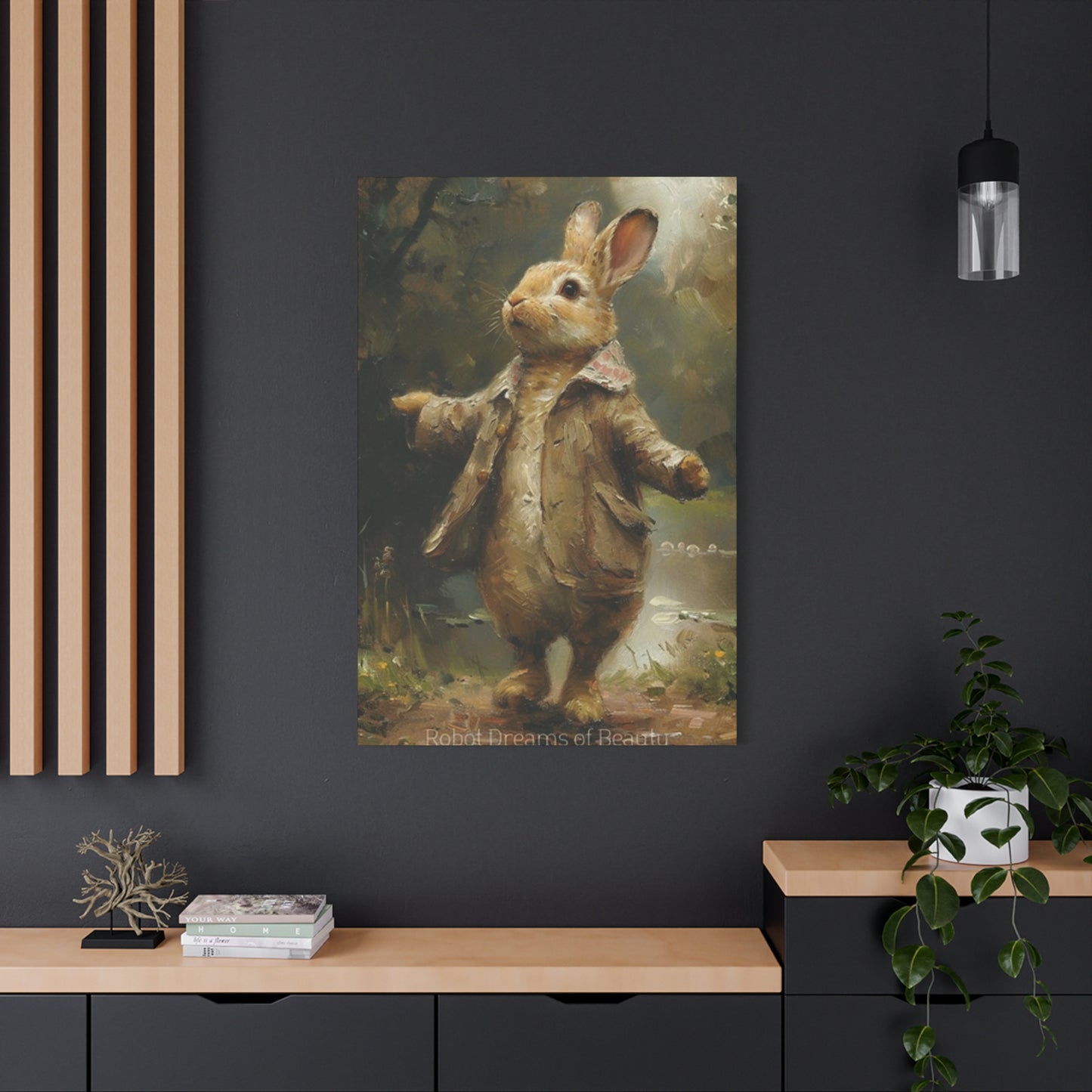Dressed Rabbit Wall Art: Creative Techniques and Artistic Expression
The enchanting world of dressed rabbit paintings has captured the hearts of art enthusiasts and collectors worldwide. This whimsical art form combines the natural charm of rabbits with elegant attire, creating captivating pieces that blend fantasy with sophisticated artistic expression. Whether you're an aspiring artist seeking to master this delightful genre or an art lover looking to appreciate the nuances of dressed animal portraiture, this comprehensive exploration will guide you through every aspect of creating and understanding these remarkable artworks.
The appeal of dressed rabbit paintings lies in their ability to evoke both nostalgia and wonder. These charming creatures, adorned in period costumes or contemporary fashion, serve as vehicles for storytelling and emotional expression. The juxtaposition of innocent woodland animals with human clothing creates a delightful tension that speaks to our imagination and invites viewers into a world where anthropomorphic characters reign supreme.
Mastering the Art of Painting Costumed Rabbits for Home Decoration
Creating dressed rabbit paintings requires a deep understanding of both animal anatomy and fabric rendering. The foundation of any successful dressed rabbit artwork begins with studying rabbit proportions and characteristics. Rabbits possess distinctive features including elongated ears, compact bodies, powerful hind legs, and expressive eyes that must be accurately captured before adding clothing elements.
When beginning your dressed rabbit painting, start with detailed sketches focusing on the rabbit's natural posture and movement. Observe how rabbits sit, stand, and interact with their environment. This observational foundation will inform how clothing will drape and move on their forms. The key to believable dressed animal paintings lies in understanding how fabric behaves on non-human anatomy.
Color selection plays a crucial role in establishing the mood and personality of your dressed rabbit character. Warm earth tones like sienna, umber, and ochre work beautifully for rabbit fur, while cooler tones can create more fantastical interpretations. The clothing colors should complement the rabbit's natural coloring while serving the overall compositional harmony.
Lighting considerations are paramount when painting dressed rabbits. Natural lighting scenarios work best, with soft window light or outdoor settings providing believable illumination. Pay attention to how light falls on both fur texture and fabric surfaces, as these materials interact with light differently. Fur tends to absorb and scatter light, creating soft shadows, while fabrics may reflect light more directly depending on their material properties.
Brushwork techniques vary depending on whether you're rendering fur or fabric. For rabbit fur, use short, directional strokes that follow the natural growth patterns. Build up fur texture gradually, starting with base colors and adding highlights and shadows to create depth and dimension. For clothing, longer, smoother strokes help convey the flow and drape of fabric materials.
Attention to anatomical accuracy ensures your dressed rabbit appears natural and believable within its fantastical context. Study rabbit skeletal structure to understand joint locations and movement limitations. This knowledge prevents awkward poses that might detract from the painting's charm. Remember that while the concept is whimsical, the execution should demonstrate solid artistic fundamentals.
Comprehensive Approach to Developing Costumed Rabbit Artwork
The creative process for dressed rabbit paintings involves multiple phases of development, from initial concept to final execution. Planning your composition requires consideration of the rabbit's personality, the story you wish to tell, and the emotional response you want to evoke from viewers. Each element of the painting should contribute to a cohesive narrative that engages the audience's imagination.
Character development begins with defining your rabbit's personality traits. Will your rabbit be dignified and regal, wearing elaborate Victorian dress? Perhaps playful and mischievous in casual contemporary clothing? Or mysterious and elegant in gothic attire? These personality decisions influence everything from pose selection to color palette choices.
Environmental context adds depth and meaning to dressed rabbit paintings. Consider whether your rabbit inhabits a grand mansion, cozy cottage, formal garden, or fantastical landscape. The background should support and enhance the character without overwhelming the central figure. Subtle environmental details can provide narrative clues about your rabbit's story and lifestyle.
Compositional planning involves determining the optimal placement of your dressed rabbit within the picture plane. Traditional portrait composition rules apply, with considerations for balance, focal points, and visual flow. The rule of thirds can guide placement decisions, while leading lines within the composition can direct viewer attention to key areas of interest.
Preparatory studies and sketches are invaluable tools in the development process. Create multiple small studies exploring different poses, clothing options, and compositional arrangements. These preliminary works allow experimentation without committing to a final composition prematurely. Document successful elements from various studies to incorporate into your final painting.
Reference gathering enhances authenticity in both rabbit anatomy and period costume details. Collect photographs of rabbits in various poses, paying attention to proportional relationships and characteristic gestures. Similarly, research historical or contemporary clothing styles to ensure accurate representation of garment construction, fabric draping, and period-appropriate details.
Technical preparation includes selecting appropriate painting surfaces, brushes, and pigments for your intended outcome. Canvas, wood panels, or paper each offer different advantages depending on your technique and artistic goals. Quality brushes designed for detail work and broader application ensure optimal paint handling throughout the creative process.
Symbolic Interpretations and Cultural Significance in Rabbit Fashion Art
Dressed rabbit artwork carries rich symbolic meaning that transcends mere whimsical decoration. Throughout art history, rabbits have symbolized fertility, rebirth, and innocence, while clothing represents social status, cultural identity, and human civilization. The combination creates complex layers of meaning that viewers can interpret on multiple levels.
The tradition of anthropomorphic animal art dates back centuries, with notable examples in medieval manuscripts, folk art traditions, and children's literature illustrations. Dressed rabbits specifically gained popularity during the Victorian era, when elaborate clothing and social hierarchy were prominent cultural themes. These historical connections add depth and gravitas to contemporary dressed rabbit paintings.
Cultural interpretations vary across different societies and time periods. In some contexts, dressed animals represent the tension between nature and civilization, while others view them as celebrations of imagination and creativity. Understanding these cultural nuances helps artists create more meaningful and resonant artwork that connects with diverse audiences.
Psychological aspects of dressed animal art relate to human tendencies toward anthropomorphization and emotional projection. Viewers often project human emotions and characteristics onto animal subjects, creating personal connections with the artwork. This psychological engagement makes dressed rabbit paintings particularly effective as conversation pieces and emotional focal points in domestic settings.
Religious and mythological connections exist in various cultural traditions featuring rabbit symbolism. From the Celtic tradition of rabbit as messenger between worlds to Asian folklore celebrating rabbit wisdom and longevity, these cultural associations enrich the interpretive potential of dressed rabbit artwork. Artists can consciously incorporate these symbolic elements to add depth to their creative expression.
Modern interpretations often focus on themes of identity, transformation, and social commentary. Contemporary artists use dressed rabbit imagery to explore questions about authenticity, social conformity, and the masks we wear in daily life. These deeper meanings elevate dressed rabbit art beyond mere decoration to meaningful artistic statement.
The therapeutic value of creating and viewing dressed rabbit art should not be underestimated. The whimsical nature of these paintings often evokes joy, wonder, and childlike imagination in both creators and viewers. This emotional response can provide comfort, inspiration, and escape from everyday stresses, making dressed rabbit art particularly valuable in residential and healthcare environments.
Advanced Mixed Media Applications for Rabbit Portrait Enhancement
Mixed media techniques offer exciting possibilities for enhancing dressed rabbit paintings beyond traditional paint applications. Incorporating various materials and techniques can add texture, depth, and visual interest that pure painting alone might not achieve. These approaches require careful planning to ensure cohesive integration of different media elements.
Collage elements can introduce authentic fabric textures to dressed rabbit paintings. Small pieces of actual lace, velvet, silk, or other materials can be adhered to the painted surface to create tactile clothing details. This technique requires consideration of archival quality and long-term stability, using appropriate adhesives and materials that won't degrade over time.
Metallic leaf applications can add luminous highlights to jewelry, buttons, buckles, and other decorative elements on rabbit clothing. Gold, silver, and copper leaf create reflective surfaces that catch light differently than painted highlights, adding sophisticated finishing touches to elegant dressed rabbit portraits. Proper preparation and sealing ensure these delicate materials remain stable.
Textural paste and modeling compounds allow artists to build three-dimensional elements within their dressed rabbit paintings. Raised fur textures, fabric folds, decorative trim, and jewelry details can be sculpted directly on the painting surface before applying color. These dimensional elements create engaging tactile qualities that invite closer inspection.
Digital integration represents a contemporary approach to mixed media dressed rabbit art. Digital backgrounds, printed elements, or digitally manipulated components can be combined with traditional painting techniques. This hybrid approach offers unlimited possibilities for creating fantastical environments and impossible scenarios while maintaining the handcrafted quality of painted elements.
Encaustic techniques using heated wax provide unique possibilities for dressed rabbit paintings. The translucent quality of encaustic medium creates luminous effects particularly suitable for capturing the soft quality of rabbit fur. Layering capabilities allow for complex color relationships and subtle tonal variations that enhance the painting's emotional depth.
Paper and drawing media combinations expand creative possibilities through mixed drawing and painting techniques. Charcoal, pastel, colored pencil, and watercolor can be combined with acrylic or oil paints to create rich, varied surface textures. Each medium contributes its unique qualities to the overall visual experience.
Installation and presentation considerations become more complex with mixed media dressed rabbit artworks. Non-traditional elements may require special framing, mounting, or display solutions to accommodate dimensional components while protecting delicate materials. Professional conservation advice may be necessary for valuable pieces using experimental techniques.
Balancing Playfulness with Sophisticated Artistic Expression
Successful dressed rabbit art achieves a delicate balance between whimsical charm and serious artistic merit. This balance requires technical skill, thoughtful composition, and mature artistic judgment to create pieces that appeal to both children and adults while maintaining fine art credibility.
Sophistication in dressed rabbit art emerges from attention to classical artistic principles including proportion, color harmony, value relationships, and compositional balance. Even fantastical subjects benefit from solid foundational skills in drawing, painting technique, and visual design. Mastery of these fundamentals elevates whimsical subject matter to fine art status.
Narrative complexity adds depth to dressed rabbit paintings beyond simple character portrayal. Subtle storytelling elements, implied relationships between characters, or suggested backstories create engagement opportunities that reward careful observation. Viewers who invest time in studying the artwork discover additional layers of meaning and detail.
Technical excellence demonstrates artistic seriousness regardless of subject matter. Precise drawing, skillful color mixing, confident brushwork, and professional presentation standards signal that the artist takes their craft seriously. This technical foundation allows whimsical subjects to be taken seriously by critics and collectors.
Emotional resonance separates memorable dressed rabbit art from mere novelty pieces. The best examples evoke genuine emotional responses through careful attention to gesture, expression, and atmospheric qualities. These emotional connections create lasting impact that transcends initial superficial appeal.
Contemporary relevance keeps dressed rabbit art fresh and engaging for modern audiences. Artists can incorporate current fashion trends, social commentary, or contemporary cultural references while maintaining the timeless appeal of the dressed animal concept. This balance between tradition and innovation ensures continued relevance.
Market positioning affects how dressed rabbit art is perceived and valued. Pieces intended for fine art markets require different approaches than those designed for commercial or decorative purposes. Understanding target audiences and market expectations helps artists develop appropriate strategies for their creative and professional goals.
Exploring Artistic Movements in Anthropomorphic Animal Portraiture
The tradition of realistic dressed rabbit portraiture draws inspiration from centuries of fine art portrait painting conventions. Academic training in human portraiture provides essential skills that translate directly to animal subjects. Understanding classical portrait lighting, composition, and pose selection elevates dressed rabbit paintings to museum-quality standards.
Realistic rendering requires meticulous attention to anatomical accuracy, fur texture, and fabric behavior. Artists working in this style often spend considerable time studying rabbit anatomy and movement patterns to achieve convincing representations. High-quality reference materials and direct observation are essential for achieving photographic levels of accuracy.
Color relationships in realistic dressed rabbit portraits follow traditional portrait painting principles. Flesh tones are replaced by fur colors, but the same principles of warm and cool color temperature, reflected light, and atmospheric perspective apply. Mastering these color relationships creates convincing three-dimensional form and environmental integration.
Detail work in realistic paintings requires patience and systematic approach. Building up complex textures like fur, lace, or embroidered fabric demands careful layering of color and value. Working from general to specific, artists gradually refine details while maintaining overall unity and coherence throughout the painting process.
Contemporary realism offers opportunities for photographic precision enhanced by artistic interpretation. Modern artists can combine traditional techniques with contemporary tools and materials to achieve unprecedented levels of detail and finish quality. Digital reference gathering and color matching technologies support traditional painting skills.
Cartoon and illustrative styles in dressed rabbit art embrace simplified forms, exaggerated proportions, and bold color choices that prioritize charm and appeal over strict accuracy. These approaches often draw from animation, children's book illustration, and graphic design traditions to create engaging and accessible artwork.
Character design principles from animation and illustration inform cartoon-style dressed rabbit art. Exaggerated features, simplified forms, and clear silhouettes create memorable characters that reproduce well in various formats. Understanding principles of character appeal and personality expression through design choices enhances artistic impact.
Color palette strategies in cartoon styles often employ limited, harmonious color schemes that create strong visual impact. Bright, saturated colors and high contrast relationships grab attention and convey energy and playfulness. These color choices support the lighthearted nature of cartoon-style dressed rabbit art.
Stylization techniques allow artists to emphasize particular aspects of their dressed rabbit characters while de-emphasizing others. Simplified anatomy, geometric forms, and graphic treatments create distinctive artistic voices that stand out in crowded marketplaces. Developing personal stylistic approaches builds artistic recognition and career opportunities.
Costume Design Principles for Painted Rabbit Characters
Period-appropriate costume selection requires research into historical clothing construction, materials, and social significance. Victorian, Edwardian, Renaissance, and other historical periods each offer distinct aesthetic qualities and cultural associations that can enhance dressed rabbit character development. Accuracy in period details demonstrates artistic seriousness and historical knowledge.
Historical clothing construction knowledge helps artists understand how garments were made and how they would appear when worn. Understanding techniques like button placement, seam construction, and fabric draping creates more convincing costume representation. This knowledge prevents anachronistic errors that might detract from the painting's credibility.
Fabric selection considerations include how different materials behave visually under various lighting conditions. Silk, velvet, cotton, wool, and linen each have characteristic appearance qualities that must be accurately rendered. Understanding these material properties helps artists make informed decisions about costume choices for their rabbit characters.
Contemporary fashion integration allows artists to create dressed rabbits wearing current styles while maintaining the whimsical appeal of the concept. Modern clothing offers opportunities for social commentary, cultural reference, and audience connection. Balancing contemporary relevance with timeless appeal requires careful consideration of fashion choices.
Custom costume design for dressed rabbit characters offers unlimited creative possibilities. Artists can invent unique clothing styles that serve the narrative and aesthetic goals of their artwork. This approach requires understanding basic garment construction principles to create believable fictional costumes.
Seasonal and occasion-appropriate clothing choices add narrative context to dressed rabbit paintings. Wedding attire, holiday costumes, professional uniforms, or recreational clothing each suggest different stories and character backgrounds. These costume choices guide viewer interpretation and emotional response to the artwork.
Cultural costume exploration introduces global fashion traditions into dressed rabbit art. Traditional clothing from various cultures can create educational opportunities and celebrate diversity while maintaining the whimsical appeal of dressed animals. Respectful representation requires research and cultural sensitivity.
Character Development Through Artistic Expression in Rabbit Paintings
Personality expression through pose selection requires understanding body language and gesture communication. Confident characters adopt upright, open postures, while shy or mysterious characters might be portrayed with more closed, protective positions. Translating human body language concepts to rabbit anatomy requires careful observation and artistic interpretation.
Facial expression development in rabbit paintings presents unique challenges since rabbit facial anatomy differs significantly from human features. Subtle variations in ear position, eye expression, and mouth gesture can convey complex emotional states. Artists must study rabbit behavior and facial expressions to achieve convincing character portrayal.
Prop integration adds storytelling elements that support character development. Books, musical instruments, flowers, jewelry, or other objects can suggest hobbies, interests, or personality traits. Careful prop selection and placement enhance narrative potential without overwhelming the central character.
Environmental storytelling through background elements provides context for dressed rabbit characters. Formal gardens suggest refinement and elegance, while cozy library settings imply intellectual pursuits. Background choices should support and enhance character interpretation without competing for attention.
Color psychology applications in dressed rabbit paintings can reinforce personality traits and emotional themes. Warm colors suggest approachable, friendly characters, while cool colors might indicate more reserved or mysterious personalities. Understanding color emotional associations helps artists make strategic choices that support their artistic intentions.
Gesture and movement representation capture character personality through dynamic poses and implied motion. Active, energetic characters benefit from poses suggesting movement and vitality, while contemplative characters work better in static, thoughtful positions. Balancing dynamic interest with posed portrait requirements requires careful planning.
Series development allows artists to explore character evolution and relationships over multiple paintings. Creating families of rabbit characters, seasonal variations, or narrative sequences provides opportunities for deeper storytelling and audience engagement. Series work also offers commercial advantages through collection potential.
Creating Child-Friendly Dressed Rabbit Artwork for Young Audiences
Age-appropriate content considerations ensure dressed rabbit art remains suitable for children while maintaining artistic quality. Gentle themes, positive emotions, and encouraging messages create artwork that parents feel comfortable displaying in children's environments. Understanding child psychology and developmental stages informs appropriate artistic choices.
Safety in materials and presentation becomes crucial for artwork intended for children's rooms. Non-toxic paints, secure framing, and appropriate sizing prevent potential hazards while ensuring long-term durability. Professional framing with safety glass and secure mounting hardware protects both artwork and young viewers.
Educational value can be incorporated into dressed rabbit paintings through historical costume details, cultural elements, or nature education opportunities. These subtle educational components add value for parents while maintaining entertainment value for children. Balancing education with appeal requires careful integration of informational elements.
Interactive elements, while primarily visual in traditional paintings, can be suggested through visual games, hidden details, or recognizable objects that children can identify and discuss. These engagement strategies transform passive viewing into active participation, enhancing the artwork's value as both decoration and entertainment.
Growth and development considerations recognize that children's tastes and interests evolve rapidly. Artwork that appeals to toddlers may seem babyish to school-age children. Understanding these developmental transitions helps create artwork with lasting appeal that grows with the child.
Positive messaging through dressed rabbit art can reinforce values like kindness, courage, friendship, and creativity. Subtle incorporation of these themes through character portrayal and visual storytelling creates artwork that entertains while supporting positive character development in young viewers.
Gender considerations in contemporary children's art require sensitivity to evolving attitudes about gender roles and expression. Dressed rabbit characters can challenge traditional stereotypes while remaining appealing to children of all gender identities. Inclusive representation creates more welcoming and relevant artwork for diverse audiences.
Professional Framing and Exhibition Strategies for Rabbit Art
Museum-quality framing standards protect artwork while enhancing presentation and perceived value. Acid-free matting materials, conservation-grade glazing, and archival mounting techniques ensure long-term preservation of dressed rabbit paintings. Professional framing investment pays dividends in artwork longevity and marketability.
Lighting considerations for displaying dressed rabbit art affect both preservation and visual impact. UV-filtered lighting prevents fade damage while proper illumination levels showcase the artwork's colors and details effectively. Understanding conservation lighting principles protects valuable artwork investments.
Room integration strategies help dressed rabbit paintings complement existing decor while maintaining their visual impact. Scale relationships, color coordination, and thematic consistency create harmonious installations that enhance both artwork and living environment. Professional installation advice ensures optimal presentation.
Collection display approaches for multiple dressed rabbit pieces require careful curation and spacing decisions. Gallery wall arrangements, symmetrical groupings, or themed clusters each offer different aesthetic experiences. Understanding exhibition principles creates more impactful installations than random placement.
Rotation and storage considerations preserve artwork while allowing variety in display choices. Proper storage conditions prevent damage during non-display periods, while rotation schedules keep collections fresh and engaging. Understanding conservation storage principles protects artwork investments.
Insurance and documentation needs for valuable dressed rabbit art include professional appraisals, condition reports, and photographic documentation. These records support insurance claims, resale transactions, and estate planning needs. Maintaining accurate artwork records protects financial and artistic investments.
Exhibition opportunities for dressed rabbit art range from local art shows to specialized animal art exhibitions. Understanding appropriate venues, submission requirements, and presentation standards opens opportunities for artistic exposure and career development. Building exhibition experience enhances artistic credibility and market presence.
Narrative Development Through Sequential Rabbit Character Art
Storytelling potential in dressed rabbit paintings extends far beyond single character portraits to complex narrative sequences and character relationships. Developing story arcs through multiple paintings creates engaging series that hold viewer attention across extended viewing sessions. These narrative elements transform individual paintings into components of larger artistic statements.
Character relationship dynamics become apparent when multiple dressed rabbit characters interact within compositions or across series installments. Romantic relationships, family structures, friendship bonds, and social hierarchies all provide rich material for artistic exploration. Understanding interpersonal dynamics helps artists create more engaging and emotionally resonant artwork.
Seasonal progression offers natural organizing principles for dressed rabbit painting series. Following characters through spring courtship, summer adventures, autumn preparations, and winter reflections creates cyclical narratives that mirror natural life patterns. These seasonal themes resonate with viewers' own experiences of temporal change and growth.
Adventure scenarios place dressed rabbit characters in exotic locations, challenging situations, or fantastical environments that test their personalities and reveal character growth. Travel themes, mystery plots, or magical encounters provide exciting contexts for character development while maintaining the whimsical appeal of dressed animal art.
Historical timeline exploration allows dressed rabbit characters to experience different time periods through costume and environmental changes. This approach combines historical education with entertainment value while showcasing the artist's research skills and technical versatility. Historical accuracy adds credibility to fantastical premises.
Moral and ethical themes can be subtly woven into dressed rabbit narratives without heavy-handed messaging. Stories about honesty, friendship, perseverance, or kindness resonate with audiences of all ages while providing meaningful content beneath entertaining surfaces. These deeper themes elevate dressed rabbit art beyond mere decoration.
Community and social structure development creates complex worlds inhabited by dressed rabbit societies with their own customs, hierarchies, and cultural practices. This world-building approach opens unlimited possibilities for ongoing series development while providing rich background material for individual character studies.
Historical Context and Evolution of Animal Fashion Art
Medieval manuscript illuminations represent some of the earliest examples of dressed animal art, where rabbits and other creatures appeared in human clothing as allegorical figures or decorative elements. These historical precedents establish dressed animal art as a legitimate artistic tradition with centuries of development and cultural significance.
Renaissance allegorical paintings often featured animals in human roles to comment on social issues, moral principles, or political situations. Understanding these historical uses of anthropomorphic imagery provides context for contemporary dressed rabbit art while demonstrating the tradition's intellectual and artistic pedigree.
Victorian era popularity of dressed animal imagery coincided with increased prosperity, elaborate fashion, and sentimental attitudes toward pets and nature. Photographs of dressed pets, illustrated children's books, and decorative objects all featured animals in human clothing during this influential period. These Victorian precedents inform contemporary appreciation for dressed rabbit art.
Children's literature traditions, particularly the works of Beatrix Potter, Lewis Carroll, and other notable authors, established dressed rabbits as beloved characters in popular culture. These literary connections add cultural resonance to contemporary dressed rabbit paintings while providing rich source material for artistic interpretation.
Folk art traditions from various cultures include examples of dressed animal imagery in functional and decorative contexts. Understanding these grassroots artistic traditions provides alternative perspectives on dressed animal art that complement fine art approaches. Folk art influences can enrich contemporary artistic expression.
Commercial art development through advertising, packaging design, and product illustration has utilized dressed animal imagery extensively throughout the twentieth century. Understanding these commercial applications helps artists navigate contemporary market expectations while maintaining artistic integrity in their dressed rabbit paintings.
Contemporary fine art movements have embraced anthropomorphic imagery as vehicles for social commentary, psychological exploration, and cultural critique. Understanding these serious artistic applications elevates dressed rabbit art beyond novelty status to legitimate contemporary art practice.
Technical Mastery in Color Theory and Texture Rendering
Color temperature relationships in dressed rabbit paintings require understanding how warm and cool colors interact to create spatial depth, mood, and focal emphasis. Warm colors advance visually while cool colors recede, creating opportunities for compositional control and atmospheric effects. Mastering these relationships enhances overall artistic impact.
Fur texture rendering techniques vary depending on rabbit breed characteristics and lighting conditions. Long-haired breeds require different brushwork approaches than short-haired varieties. Understanding these textural variations helps artists make informed decisions about rabbit breed selection for their artistic purposes.
Fabric material representation demands knowledge of how different textiles behave under various lighting conditions. Shiny materials like silk or satin reflect light directly, creating bright highlights and sharp value contrasts. Matte materials like wool or cotton absorb light more evenly, producing softer value transitions and subdued highlights.
Layering techniques in oil or acrylic painting allow artists to build complex color relationships through transparent and opaque paint applications. Understanding how different pigments interact when layered helps artists achieve rich, luminous color effects that enhance the magical quality of dressed rabbit artwork.
Color mixing strategies for achieving realistic fur colors require understanding undertones and color temperature variations within seemingly simple color areas. Rabbit fur often contains multiple color notes that change based on lighting conditions and seasonal variations. Accurate color observation and mixing skills create more convincing representations.
Value relationships establish three-dimensional form and spatial depth in dressed rabbit paintings. Understanding how light creates highlight, midtone, and shadow patterns on both organic and manufactured surfaces helps artists model form convincingly. Strong value patterns create more dramatic and engaging artwork.
Brushwork techniques for different painting phases require various brush types and handling methods. Initial blocking requires broader brushes and confident stroke application, while detail work demands smaller brushes and precise control. Matching brushwork to painting phase creates more efficient and successful artistic outcomes.
Dressed Rabbit Artwork as Meaningful Gift Options
Personalization possibilities in dressed rabbit paintings create unique gift opportunities that reflect recipient interests, personalities, or life experiences. Custom costume choices, environmental settings, or personal objects incorporated into paintings create one-of-a-kind artworks that demonstrate thoughtful consideration and artistic investment.
Commemorative potential for special occasions like weddings, anniversaries, births, or achievements makes dressed rabbit art particularly valuable as meaningful gifts. These artworks serve as lasting reminders of important life events while providing ongoing decorative and emotional value. Understanding commemoration needs helps artists create more impactful gift artwork.
Age-appropriate variations ensure dressed rabbit gifts remain suitable across different life stages and recipient ages. Children's versions emphasize bright colors and playful elements, while adult versions can incorporate sophisticated techniques and mature themes. Flexible artistic approaches accommodate diverse gift-giving needs.
Cultural sensitivity considerations become important when creating dressed rabbit gifts for recipients from different cultural backgrounds. Understanding cultural attitudes toward animal representation, religious considerations, and aesthetic preferences helps artists create welcome and appropriate gift artwork.
Presentation packaging for dressed rabbit artwork gifts requires attention to professional appearance and protective function. Quality framing, elegant wrapping, and informative documentation enhance the gift-giving experience while protecting the artwork during transport and storage. Professional presentation adds perceived value to artistic gifts.
Emotional impact strategies focus on creating artwork that generates positive emotional responses and lasting memories. Understanding recipient personalities, preferences, and life situations helps artists make artistic choices that maximize emotional resonance and gift satisfaction.
Budget considerations for custom dressed rabbit artwork require balancing artistic quality with price accessibility. Understanding different price points and their corresponding quality levels helps both artists and gift purchasers make appropriate investment decisions for their specific needs and budgets.
Learning from Master Artists in Animal Portraiture Traditions
Classical training principles from master animal painters provide foundational skills applicable to dressed rabbit art. Studying the techniques of artists like George Stubbs, Rosa Bonheur, or William Huggins reveals approaches to animal anatomy, movement, and character expression that remain relevant for contemporary artists.
Contemporary innovation in animal portraiture demonstrates how traditional skills can be combined with modern techniques and concepts to create fresh, relevant artwork. Understanding current trends and innovative approaches helps artists develop distinctive personal styles while building on historical foundations.
Technical analysis of masterwork paintings reveals construction methods, color strategies, and compositional approaches that can be adapted to dressed rabbit subjects. Close study of museum-quality animal paintings provides learning opportunities that improve artistic skills and understanding.
Style development through master study helps artists identify influences and develop personal artistic voices. Understanding how master artists solved technical and aesthetic challenges provides guidance for contemporary artistic decision-making while encouraging individual expression and innovation.
Academic drawing skills form the foundation for all successful painting endeavors, including dressed rabbit art. Understanding proportional relationships, perspective principles, and form construction through academic training creates stronger artistic outcomes regardless of subject matter or style preferences.
Color theory applications from master painters demonstrate sophisticated approaches to creating harmonious, expressive color relationships. Understanding how master artists used color to create mood, focal points, and spatial effects provides valuable knowledge for dressed rabbit artists seeking to improve their technical skills.
Composition strategies from successful animal portraits reveal how master artists created engaging, well-balanced artworks that hold viewer attention. Understanding these compositional approaches helps contemporary artists make better design decisions in their dressed rabbit paintings.
Beginner-Friendly Approaches to Dressed Rabbit Art Creation
Basic material selection for beginning dressed rabbit artists focuses on affordable, quality supplies that support learning without overwhelming novice artists with complex choices. Understanding essential materials versus optional additions helps beginners invest wisely in their artistic education and equipment.
Skill development progression provides structured learning approaches that build competency gradually through achievable challenges. Beginning with simple projects and advancing to complex techniques creates sustainable learning experiences that maintain motivation while building solid foundational skills.
Practice exercise design helps beginning artists focus on specific skill development areas like color mixing, brushwork, or composition without becoming overwhelmed by multiple challenges simultaneously. Targeted practice sessions accelerate learning and build confidence in individual skill areas.
Error correction and learning opportunities transform common beginner mistakes into valuable learning experiences. Understanding typical challenges and their solutions helps beginning artists avoid frustration while developing problem-solving skills essential for artistic growth.
Reference material utilization teaches beginning artists how to find, evaluate, and use photographic and other reference sources effectively. Understanding reference limitations and applications helps beginners create more original and successful artwork while avoiding copyright and creative dependency issues.
Community and critique engagement provides valuable feedback and encouragement for beginning dressed rabbit artists. Understanding how to give and receive constructive criticism helps beginners improve their skills while building supportive artistic relationships that sustain long-term creative development.
Goal setting and progress tracking help beginning artists maintain motivation and measure improvement over time. Understanding realistic expectations and achievement timelines prevents discouragement while encouraging consistent practice and skill development efforts.
Combining Playfulness with Professional Artistic Standards
Professional technique standards apply to whimsical subjects just as rigorously as to serious subject matter. Understanding academic drawing principles, color theory applications, and composition guidelines creates dressed rabbit artwork that meets fine art quality standards while maintaining its entertaining and accessible appeal.
Market positioning strategies help artists navigate the balance between commercial appeal and artistic credibility. Understanding different market segments and their expectations helps artists make strategic decisions about style, subject matter, and presentation that support their professional goals and artistic integrity.
Quality control measures ensure consistency and excellence across dressed rabbit artwork production. Understanding technical standards, material quality requirements, and presentation criteria helps artists maintain professional reputations while building sustainable artistic careers.
Client communication skills become essential when creating custom dressed rabbit artwork or working with galleries and collectors. Understanding client needs, managing expectations, and maintaining professional relationships supports successful artistic career development in this specialized market niche.
Portfolio development for dressed rabbit artists requires strategic selection and presentation of artwork that demonstrates technical skill, creative range, and professional capability. Understanding portfolio requirements for different opportunities helps artists present their work effectively to various audiences.
Pricing strategies for dressed rabbit artwork require understanding market values, production costs, and target audience expectations. Appropriate pricing supports both artist livelihood and market accessibility while reflecting the artwork's quality and value proposition accurately.
Career development opportunities in dressed rabbit art range from illustration work to fine art sales to teaching opportunities. Understanding various career paths helps artists make strategic decisions about skill development, marketing efforts, and professional networking that support their long-term artistic and financial goals.
Conclusion
The enchanting world of dressed rabbit paintings represents a unique intersection of technical artistry, imaginative storytelling, and cultural expression that continues to captivate audiences across generations. Throughout this comprehensive exploration, we have discovered that creating successful dressed rabbit artwork requires much more than simply placing clothing on animal subjects. It demands mastery of fundamental artistic principles, deep understanding of both animal anatomy and fabric behavior, and sophisticated appreciation for the cultural and symbolic significance these whimsical characters carry.
The technical aspects of dressed rabbit painting encompass a wide range of skills, from accurate anatomical rendering to convincing fabric representation. Artists must understand how rabbit proportions and movement patterns affect clothing drape and appearance, while simultaneously mastering color relationships that create believable form and atmospheric depth. The integration of mixed media techniques opens additional possibilities for texture and visual interest, allowing artists to push creative boundaries while maintaining technical excellence. These skills, combined with strong compositional sense and professional presentation standards, elevate dressed rabbit art from mere novelty to serious artistic expression worthy of fine art consideration.
The symbolic and cultural dimensions of dressed rabbit imagery add layers of meaning that enrich both creation and appreciation of these artworks. From historical precedents in medieval manuscripts to contemporary interpretations addressing social commentary and personal identity, dressed rabbit paintings serve as vehicles for complex communication that extends far beyond surface entertainment. Understanding these deeper meanings helps artists create more resonant work while providing viewers with richer interpretive experiences that reward careful observation and contemplation.
The versatility of dressed rabbit art as both serious artistic expression and accessible decoration makes it particularly valuable in contemporary art markets. These paintings can function effectively in children's environments while simultaneously appealing to sophisticated adult collectors. This broad appeal requires careful balance between whimsical charm and technical competence, ensuring that entertainment value doesn't compromise artistic integrity. The most successful dressed rabbit artists achieve this balance through thorough preparation, skilled execution, and thoughtful consideration of audience needs and expectations.
The educational and therapeutic benefits of dressed rabbit art extend its value beyond mere aesthetic appreciation. Creating these paintings provides opportunities for skill development, cultural exploration, and personal expression that support both artistic and personal growth. Viewing dressed rabbit artwork can evoke positive emotions, spark imagination, and provide comfort through their inherently optimistic and gentle nature. These benefits make dressed rabbit paintings particularly valuable in educational, healthcare, and residential settings where positive emotional impact is especially important.
The future of dressed rabbit art appears bright, with continuing opportunities for innovation and development within this established tradition. Emerging technologies, evolving cultural perspectives, and changing aesthetic preferences all provide opportunities for contemporary artists to contribute fresh interpretations while honoring historical precedents. The enduring appeal of anthropomorphic imagery suggests that dressed rabbit art will continue finding receptive audiences who appreciate its unique combination of technical skill, creative imagination, and emotional warmth.
For artists embarking on dressed rabbit painting journeys, success requires commitment to both technical excellence and creative exploration. Understanding fundamental principles provides the foundation for innovation, while maintaining curiosity and playfulness ensures that the work retains its essential charm and appeal. The most rewarding dressed rabbit artworks result from balancing careful observation with imaginative interpretation, creating pieces that are both technically accomplished and emotionally engaging.
The community of dressed rabbit artists and enthusiasts continues growing, providing support, inspiration, and market opportunities for both established and emerging artists. This community values both tradition and innovation, encouraging artistic development while maintaining appreciation for the genre's historical significance and cultural impact. Participation in this community through exhibitions, workshops, and online platforms enhances both artistic growth and professional development opportunities.
The commercial viability of dressed rabbit art spans multiple market segments, from original paintings to prints, from children's illustration to fine art collecting. Understanding these various markets and their specific requirements helps artists develop sustainable careers while maintaining artistic integrity and personal satisfaction. The key to success lies in identifying authentic personal artistic voices within the dressed rabbit tradition while meeting professional standards and market expectations.
Looking toward the future, dressed rabbit art will likely continue evolving as artists explore new techniques, cultural perspectives, and technological possibilities while maintaining connection to the tradition's core appeals of technical skill, imaginative content, and emotional warmth. The enduring popularity of anthropomorphic imagery in literature, film, and digital media suggests that dressed rabbit paintings will remain relevant and appealing to diverse audiences seeking art that combines sophistication with accessibility, technical excellence with emotional engagement, and cultural significance with personal enjoyment.

















